
|
 |

|
 |
Revitalising Kuchipudi art and heritage - Sudha Sridhar e-mail: sudhasridhar@hotmail.com November 13, 2014 (The article was first published in the Silicon Andhra 2012 Souvenir) "As one enters into this majestic village flanked by a large International stature auditorium with state-of-the art facilities and a huge edifice, housing a hi tech aesthetic library with archiving and modern amenities, a museum showcasing all the glory of the past, an autonomous university with a very robust and dedicated work force which includes revered gurus, earnest students of all stature learning the various nuances of Kuchipudi dance, Yakshaganam, the original genre of the contemporary art form, various allied arts and crafts like mask making, Pagetiveshalu, stage craft, a la Gurukul style and facilities for study and stay to match the highest standards one sees in any universities of the world, beehive of activity all over the village with each step and brick having a wonderful unfolding story to be soaked into....." The above description could easily be that of Kuchipudi village, the primary seat of the art form, which has a hoary past, a rich cultural legacy which needs to be preserved. Kuchipudi village is perhaps the only place in India, which has given its name to a classical dance-form. The history of this village and its inhabitants is interwoven with the evolution of the exquisite dance form of Kuchipudi. This Andhra Pradesh village was originally known variously as 'Kuchelapuram,' 'Kuchelapuri' (one legend holds that Krishna's devotee Kuchela lived here), 'Kuchennapoodi' (after Kuchenna, a famous disciple of Siddhendra Yogi) and 'Kuchipundi.' It was populated by Bhagavathulu and their families and the village has produced some of the greatest classical dancers and teachers of the country. The Kuchipudi Bhagavathamelam, the original repository, the progenitor of the Kuchipudi dance of today, have been the acknowledged and documented torch bearers of the art form for centuries while being mainly confined to Kuchipudi Agraharam in Muvva Taluka, Krishna district, a hallowed spot with renowned practitioners of the art calling it a "pilgrimage centre" - the village akin to be a "wonderful temple" and "cultural treasure." 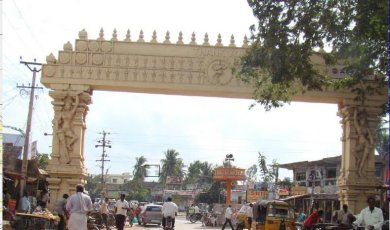 Arch at Kuchipudi Agraharam entrance  Bala Tripurasundari temple and the stage for performance Milestone in the history of the dance form and village This particular dance form reportedly existed from quite a few centuries back - historians reckon that there is distinct reference to this in relics available in Haludu's Gadha Sapta Sathi. Influence of this dance form in the works of so many writers, authors, musicologists from then on and interdependence could be ascertained from many cross references available to that effect in scriptures and relics like Shiva Kavi's Panditharadhaya Charithra and Basava Puranam, Jayappa Sena's Nritta Ratnavalli, etc. This makes carbon dating Kuchipudi dance form very difficult and it can be ascertained that the name taken after the place was much later. One of the earliest-known maestros from this village was saint Siddhendra Yogi. Though the principle of the Kuchipudi dance form is totally based on Bharata's Natya Shastra, Nandikeshwar's Bharatharnava and Abhinaya Darpanam, his sterling contribution was 'Bhama Kalapam,' a Telugu dance-drama, where the lyrics, tunes and script were by him. To have this enacted, Siddhendra Yogi, also a great choreographer, selected a group of boys from Kuchipudi village and trained them. The Kuchipudi dance form which has the Samskrutha Rupakam, Slokha Abhinayam, Kouthvam, Tillana, Swarapallavi, Nritya Natikas, Brinda Natyam, Ekapathra Kelikas, Tarangams, Kelikas, Yakshaganams, Jathiswarams, Swarajathis, Pada Varnams, Pagetivesham, Dvipatra Kelikas, Keerthanas, Daruvu and Nruthiya Rupakam in it, the stellar contribution Bhama Kalapam by Siddhendra Yogi stands out as a jewel in the crown. This probably is a milestone in the history of the dance form and village. Unlike other dance forms wherein the practitioners generally had the patronage of either Rajas or temples, Kuchipudi dance form which was primarily restricted to the male members of the Bhagavatamelam families was bereft of any systematic direct patronage as asthana artists. It is said that the artists themselves took care of their families and social needs out of their earnings from the dance form. The Nawab of Golconda, Abdul Hasan Tahnishah visited Masulipatanam (which is now known as Machilipatnam) and a Kuchipudi dance performance was arranged for the king. Being delighted and pleased by the performance, the king presented a piece of land of a staggering 600 acres approximately, to the Brahmin families involved in the performance and gave them the title of land written on a copper plate. Freed of tax burdens, the inhabitants found more resources to focus on their art. The tradition of having at least one male child from each of these families initiated into the art at the age of 5 years, 5 months, 5 days (which is considered an auspicious time for initiation), fortunately still continues against all odds. This tradition of passing on the knowledge and skills in spite of most of the younger generation forced to opt out for economically greener pastures speaks volumes of the love that the traditional family (nineteen in all) has for the dance form and the sacrifices made to ensure that the art form is preserved at all costs is amply brought out. A traditional Kuchipudi artist chiseled in the traditional Gurukul system in the village, is a multifaceted vidwan, adept at the nuances of music, theatre, Sanskrit and Telugu literature, Vedas, folklore, and allied arts (Theatrical makeup, mask making, set design, decorative ornamentation). For them dance is synonymous with worship and approached with a reverence. Teaching is imparted in an "organic" non structured Gurukula system even after the doors opened up to the outside world and imparted freely and generously. The artist having been exposed to the art from his childhood literally grew into the art with effortless ease and competence having the advantage of being surrounded and exposed to excellence around him. Many Kuchipudi artists born and bred in this heritage-rich village migrated to other cities and countries, which gave the art a wider platform. Their students in turn are grooming more performers. Together, they have put Kuchipudi on the cultural map of India and the world. Migration of Kuchipudi stalwarts amidst lot of personal and family sacrifices benefited initially to Melattur and very much later to cinema world in the modern era. While the role of the traditional families in preserving and protecting the art form from various contemporary dangers like dacoit attacks, frequent natural calamities (being situated in a delta region), etc are very much appreciated, loss of related documents and lack of systematized archiving is definitely a tragedy which could have been averted. It is the duty of the present generation to set in place, organizations and work with a missionary zeal setting aside individual priorities and preferences to keep the glory of the art form, the village and all the artists uppermost in their minds. The avenues that require immediate attention and offer unlimited scope for further contributions from those interested in keeping the flag of Kuchipudi art flying high are many. Kuchipudi village India's heart lies in its villages. Every rural community is steeped in folklore and indigenous craft, thus an insight into the traditional way of life, greatly enriches the visitor's experience. The heritage of Kuchipudi village and its environs offers a unique opportunity to the visitor to have a first-hand experience of the neighborhood that nurtured a beautiful art form for generations, craft traditions and the natural heritage of the surrounding areas. Cultural heritage tourism is important for various reasons; it has a positive economic and social impact, it establishes and reinforces identity, it helps preserve the cultural heritage; with culture as an instrument it facilitates harmony and understanding among people, it supports culture and helps renew tourism. 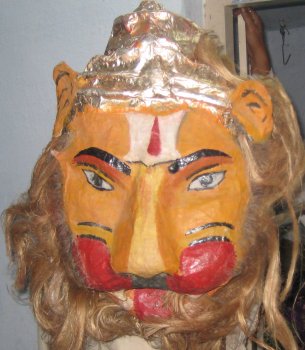 Narasimha Karalam
Mask making art in Kuchipudi Yakshaganam Ministry of Tourism, Government of India and the United Nations Development Program (UNDP) in India have partnered the promotion of 36 such rural locations, under the Endogenous Tourism Project/Rural Tourism Scheme. The initiative aims to enable local communities introduce visitors to their art and craft, culture and natural heritage. It is also essential to safeguard, conserve and promote the tangible heritage leading to the holistic development of the region. Several schemes of rural tourism have been promoted in Andhra Pradesh where the life, art, culture and heritage of the traditional communities at rural locations having a strong cultural value - crafts, performing arts etc provide a "living experience" to the discerning visitor, thereby benefitting the local community economically and socially. The National Trust for Historic Preservation in the United States defines cultural heritage tourism as "traveling to experience the places and activities that authentically represent the stories and people of the past and present." Kuchipudi village has become a thoroughfare and lacks the ambience and serenity of a campus or an art academy. Although the Kuchipudi village has a dance college and hosts an annual dance festival, it lacks a hi-tech library, archives centre and a national-level auditorium with modern state-of-the-art facilities. With the ever increasing number of artists and art lovers, there is an immediate need to scale up the available infrastructure. The government and the business barons of the state could do more in contributing towards sustaining this great tradition. Restoration of cultural ambience of Kuchipudi Agraharam involves dialogue with local panchayat, mandal, and revenue department for land use changes and with people for gaining confidence and support. A comprehensive study involving the cultural mapping of art forms, craft traditions and the tangible / intangible heritage of the region is essential to formulate policies and guidelines for the holistic development of the village and its people. Falling under the jurisdiction of Movva Mandal, Kuchipudi is surrounded by places of historical and architectural significance. Srikakulam, famous for Andhra Maha Vishnu Temple, Krishna temple in Movva, Challapalli - the capital town of Challapalli Rajas, Ghantasala Buddhist Stupa, Machilipatnam Port town - the second capital of European colonies in India and Bhatlapenumarru - the native place of Sri Pingali Venkaiya, designer of Indian national flag, are some of historically and culturally rich places around Kuchipudi. The main route to Avanigadda and Divi seema (Delta area) passes through Kuchipudi village. The region abounds in craft traditions: Kondapalli toys, the natural dyeing and printing industry at Machilipatnam to name a few. A preliminary study has been undertaken by a few students of architecture under the purview of the Panchamavedam Foundation, Turaga Foundation and INTACH Machilipatnam, but a lot needs to be done for documentation and mapping of the region in terms of the architectural heritage, in understanding the present development and ecological patterns of the region. There is a need to revitalise the Kuchipudi Agraharam preserving heritage and providing for modern needs such as a cultural heritage complex facilitating research, display museums, etc. The walking encyclopedias in the Kuchipudi village who are observed to be oozing with knowledge, eagerness to teach, non-mercenary in approach, simple but yet grand in their thoughts and actions could be the backbone of a Gurukul type organization or autonomous body that could be created on the lines of a Santiniketan (Rabindra nritya, sangeet, etc), Chennai Kalakshetra (Bharatanatyam), Kerala Kalamandalam (Kathakali, Mohiniattam, etc), Bangalore Nrityagram (Odissi). The question is whether we have anything on those lines for Kuchipudi art form which has all the essentials in it interwoven as prescribed in the Sastras. An autonomous body with less stress on compelling student numbers and taking into its fold only dedicated, interested and discerning students who are prepared to go through the entire grind to be cut as a diamond by the masters of the art form over a period of time on the lines of ancient Gurukul type of dissemination of knowledge would definitely see Kuchipudi village in the limelight once again and bring real meaning for all the efforts taken by the traditional families in preserving in its pure form all these centuries. Unlike Santiniketan, Adyar Kalakshetra and their likes which had to be built right from the concept as a brainchild of someone - Rabindranath Tagore and Rukmini Arundale respectively - when it comes to making Kuchipudi village as a one stopover for everything concerned with Kuchipudi art form, the development activities could be designed with considerable ease, since the gurus, artists, basic edifices and culture is already in place at Kuchipudi village. Kuchipudi art The art has flourished all these years on its inherent strength based on the richness of the art form and the purists' efforts in keeping it that way all these centuries, mostly passed on to the next generation by way of Gurukul system and with almost minimum documentation. The last century has seen the contribution of Kuchipudi to the art world stretching out far and wide from the village to almost most parts of the globe. While any art form gets influenced by the contemporary trends and compulsions, being one of the classical art forms, Kuchipudi should be showcased with the original basics and framework. The need of the hour is to place Kuchipudi village, the prime seat of the art form, once again as an apex place to cater to all things concerned with Kuchipudi art, like authentic documentation, ongoing archiving related activities, availability of the same for all interested by way of library and research resources, learning under Gurukul system, etc. By implementing these measures the roots are further strengthened for the art to flourish and reach out throughout the globe. The idea is not to centralize and create power centers but to foster growth yet retain the originality and purity of the basic art form and allied activities. This is of primary importance so that the art form does not get passed off to gullible and ignorant audience world over as Kuchipudi art while the practitioners are nowhere near to be called as a Kuchipudi artist. Camphor and salt both look alike but yet are they not diametrically different in all aspects! Documentation and archiving is one area that has seen far greater advancements in the modern age due to technology breakthrough. Though likes of the Vedas, ancient puranas, were all passed on centuries after centuries mostly by rote, with the availability of the leading edge technology that is offering easier and effective ways to preserve anything and everything and also since the art form is no longer confined to region, state or even country, the ramifications of not having such archiving is not to be belittled. The void created by recent loss of big stalwarts like Vempati Chinna Satyam, PVGK Sharma, Vedantam Satyanarayana Sarma, Nataraja Ramakrishna, Y Nageswara Sarma, Mahankali Mohan is not easy to be filled either to supplement their good work or the institutions to carry on the work with same zeal and ideals. With the karmic life cycle of a person almost fixed irrespective of their stature in this planet, there is really a very, very, urgent overarching need to document the art form so that it is not lost to oblivion and thrown to the atmosphere only to be picked up once again by some Yuga Purushar for the art in the form of a Siddhendra Yogi. More so at the present context when we see in the guise of development, marketing, packaging to suit the present age, many an original gets contemporized leading to the slow fading of the pristine masterpieces to that of an altogether different form and shape, robbing the future generation the access to original compositions. Documenting and archiving, museum showcasing the rich heritage, research materials in the libraries, support of the gurus and the vidwans would enable to add to the already rich cultural heritage of the art form. Avenues offered by art bodies like Sangeet Natak Akademi, measures suggested by UNESCO's Intangible Cultural Heritage List offers great scope for codification of the art form for the benefit of humanity at large. Scope for further studies related to genealogy of the traditional families, social anthropology of the area, study of old manuscripts, documentary films on various aspects, translation of books into international languages (English, Spanish and Chinese) to cater to international audience / universities / students, study on the village history, etc. could translate to opportunities for NGOs to maintain the heritage and cultural awareness of the region and art form. 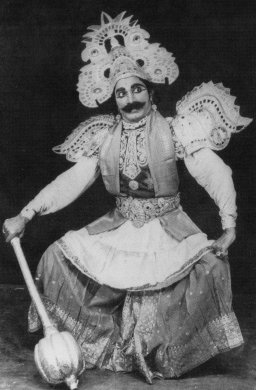 Kuchipudi Yakshaganam attire 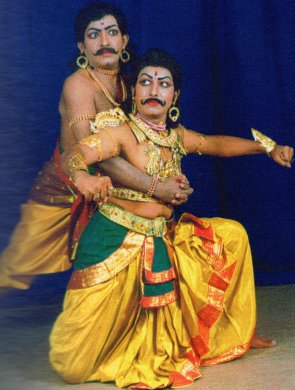 Kuchipudi Yakshaganam Kuchipudi Yakshaganam, the original genre of the art form is not provided the space that it deserves and many Yakshaganams are now a distant memory. Kuchipudi Sampradhaya Sangeetham, an essential element to the success of Kuchipudi / Kuchipudi Yakshaganam needs urgent documenting and archiving in the absence of aggressive patronage and inadequate practitioners of the same. This also offers scope for extensive research since at present Kuchipudi music is essentially based on the existing Carnatic music. Further, allied arts like Pagetiveshalu, mask making, etc too needs to be provided the boost that it requires before they mark their exit without passing on the batons to the next generation. As the important apostle of Kuchipudi art form, the facilities and infrastructure that are created in Kuchipudi village as enumerated in the article would go a long way in having a reference point for all concerned and enable the flourishing of the art form in the desired way. The Kuchipudi artiste Right from Yogi Siddhendra himself up to the 20th and present centuries, one has seen many a master don roles with aplomb and the annals of the art form have been fortunate to see many a great soul like Chinta Venkatramayya, Vedantam Lakshminarayana Sastry, Vedantam Raghavaiah, Chinta Krishnamurthy, Vedantam Parvateesam, Vedantam Satyanarayana Sarma, Vempati Chinna Satyam mesmerize the art world with their talent, dedication and performances. The art form has had its share of national and international awardees, Padma Bhushans, Padma Sris, Sangeet Natak Akademi Awardees / Fellowships /Yuva Puraskar, State Government Awards, etc. The awardees can be seen walking the streets of the village masquerading as an unrecognized commoner much to the chagrin of earnest art lovers. The role of the masters who emerged from other than the traditional families cannot be undermined. The collective efforts and the resultant growth of the art form are very much appreciated and the unsung heroes along with the established artists have borne the mantle of preserving and showcasing the art world by their steadfast pursuance and putting their heart and mind on their journey to excellence. For the survival, reaching out and flourishing of any art, the role of the charismatic brand ambassadors is very much pivotal. The revered gurus hitherto mentioned along with quite a few dedicated gurus world over had imprinted their contribution to keep the Kuchipudi flag flying high - the ever increasing number of artist numbers, bearing testimony to it. Fortunately, there is no dearth for fresh talent and all-round excellence is being witnessed in the entire length and breadth of the country and abroad too. However, the space shared by the art form in the modern stage definitely needs a push to garner the limelight and conferred with the deserving place among the various art forms. The art survives or flourishes as long as the lineage of masters of the art is maintained. Masters are created from a large of number of students. The ever increasing demands of the present age to succeed at all costs and values, the absence of a clear cut career path for arts vis-à-vis science or other spheres of education, pursuing art has been largely restricted to a few. There is a saying that what you don't learn by five years will be difficult to inculcate or learn even after 50 years, and this applies to at least the basics of life or art. Maybe that is the reason even today the tradition of initiating the child of a Kuchipudi traditional family to the dance form at the age of five is being religiously followed and the choice of further pursuing the same is left to the individual. With the busy schedule which even school students have these days, it is only a very minimum number of activities that youth can concentrate and work at it with passion. Generally, it is studies along with mainstream sports like cricket, films and popular music, leaving almost no time and energy for other vocations leave alone classical arts and more so Kuchipudi art form. Further, in the context of the modern age, incessant information explosion and ephemeral life span that any ideas/trends hold the attention of youth and elders alike, it is very much important that one is introduced to the art form in the correct and systematic manner. While any individual is aware about the aftermath of a good education with almost a certain degree of predictability, when it comes to dance or art form per se there is always a question mark with many a variable not in the control of the participant. What next after learning will be an unknown link to the process of learning. 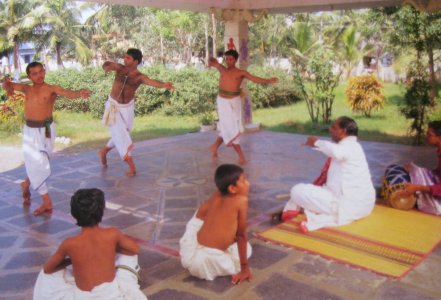 Gurukul at Kuchipudi 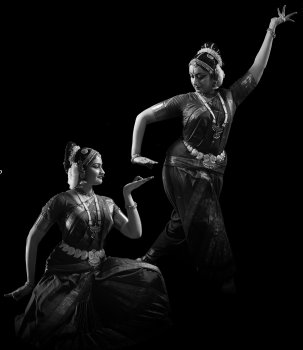 Kuchipudi Kelika A degree of substance in the lines of modern age Gurukul, a resident student of the university, having rigorous training and knowledge assimilation in all aspects of the arts in a very systematic and methodical way of learning the subject for further excellence under the watchful eyes of stalwarts and masters of the art form, will produce artists with extraordinary excellence, who will be most sought after in the world at large. This type of Gurukul will not at all be a difficult proposition since we are very much accustomed to send our children to IIT / IIM education in India and sending the young wards crossing seven seas to the Americas, Europe or Australia for higher education where the cultural shock, harsh realities for survival, etc do not deter us from encouraging or even goading our youth to pursue such avenues. This is primarily due to the fact there is very much documented history of success meted out after undergoing the initial inevitable hardship of having to be shaped as a finished product from the raw material one is at the initial stages. The same is quite true for art world too. When it comes to the solo/group items learnt by even long standing Kuchipudi dancers, they are so less in number for most of the artists due to lack of learning opportunities, a tailor made refresher course at a Gururkul Academy would aid in honing their skills and expanding their repertoire. The role of the various Governmental, NGOs, Art bodies in propagating the art form and showcasing the examples of success of excellence both in art and the worldly life by various artists would largely influence the youth to take up the art form. A career path to the artists in general including that of dancers, nattuvanars, music accompanists, allied arts and craftsman would pave way for meaningful and sustained interest among the youth to take up Kuchipudi art form. To further the cause, the formation of a legal entity with rights and duties of various stake holders elucidated is the need of the hour. Art space and artists are generally easily drawn into unwarranted and very much disturbing ego related issues, slipping to basic survival mode, challenges to continued pursuing in the wake of harsh economic realities, peer pressure, greener pastures, unhealthy practices leading to questionable values and above all no recourse mechanism for initiating remedy measures to prevent exploitation and ensure fair play. A legal entity voluntary in nature and fair in practice would address many critical issues like welfare of the artists and related artisans, undertaking genuine activities to enable flourishing of the art form and coordinate all the stake holders for an effective and efficient functioning and meet the objectives of preserving, promoting and propagating Kuchipudi art form. Forming of legal entities with unambiguous philanthropic ideals as guiding principles would definitely attract the much needed resources for ensuring the flourishing of the art from all quarters including the general public. The village, art and artists' life will have a new lease of life and growth, setting in motion the resultant upward trajectory of the art form and enable to retain and enhance the glory by sticking to real values of life while respecting the liberties, freedom and individuality of all the stake holders. The question is if Kuchipudi dance form which has reached the current stage with or in spite of the stake holders can muster the much needed fillip to scale greater heights and set an example and acquire a place of firmament in the art world for centuries to come. The answer to it is in the hearts of all the stake holders which includes the gurus, art lovers, Government and NGOs, art bodies and above all in the hearts of all the artists for it is now their opportunity to give back to the Kuchipudi art which has provided everything to what they are today. To remove the anguish of the mother of the art form, the Kuchipudi village and the traditional families that had preserved the art form all these centuries amidst challenges and replace it with one of the fulfillment of the dream as visualized in the initial para of this article with guiding spirit and blessings of all the stalwarts of Kuchipudi art form through the centuries. Are we ready for this stupendous task, and work zealously with heart and spirit with a common, unselfish and honorable goal to achieve, maybe 'Kaal' (time) is the answer or maybe the next small 'adagu' that one places in this direction is the answer! The choice is individual while the results are collective! Sudha Sridhar is an art and cultural activist. Post your comments Please provide your name and email id when you use the Anonymous profile in the blog to post a comment. All appropriate comments posted with name & email id in the blog will also be featured in the site. |